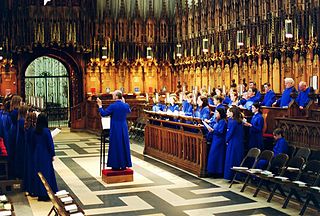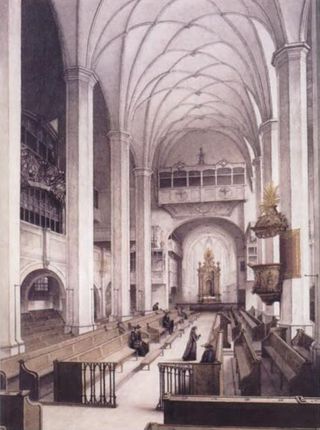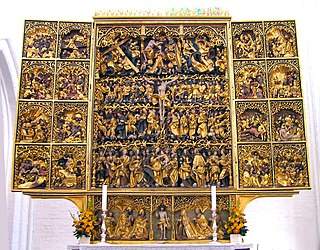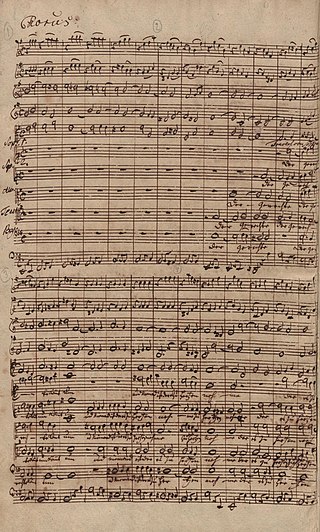Related Research Articles

A choir is a musical ensemble of singers. Choral music, in turn, is the music written specifically for such an ensemble to perform. Choirs may perform music from the classical music repertoire, which spans from the medieval era to the present, or popular music repertoire. Most choirs are led by a conductor, who leads the performances with arm, hand, and facial gestures.

The Mass is a form of sacred musical composition that sets the invariable portions of the Christian Eucharistic liturgy, known as the Mass.

Ach Gott, vom Himmel sieh darein, BWV 2 is a chorale cantata composed by Johann Sebastian Bach for the second Sunday after Trinity in 1724. First performed on 18 June in Leipzig, it is the second cantata of his chorale cantata cycle. The church cantata is based on Martin Luther's 1524 hymn "Ach Gott, vom Himmel sieh darein", a paraphrase of Psalm 12.

Jesu, meine Freude, BWV 227, is a motet by Johann Sebastian Bach. The longest and most musically complex of Bach's motets, it is set in eleven movements for up to five voices. It is named after the Lutheran hymn "Jesu, meine Freude" with words by Johann Franck, first published in 1653. The motet contains the six stanzas of the hymn in its odd-numbered movements. The hymn tune by Johann Crüger appears in all of these movements in different styles of chorale settings. The text of the motet's even-numbered movements is taken from the eighth chapter of the Epistle to the Romans, a passage that influenced key Lutheran teachings. The hymn, written in the first person with a focus on an emotional bond with Jesus, forms a contrasting expansion of the doctrinal biblical text. Bach set both texts alternating with and complementing each other, in a structure of symmetries on different layers.

Ernst Pepping was a German composer of classical music and academic teacher. He is regarded as an important composer of Protestant sacred music in the 20th century.

The cantatas composed by Johann Sebastian Bach, known as Bach cantatas, are a body of work consisting of over 200 surviving independent works, and at least several dozen that are considered lost. As far as known, Bach's earliest cantatas date from 1707, the year he moved to Mühlhausen, although he may have begun composing them at his previous post in Arnstadt. Most of Bach's church cantatas date from his first years as Thomaskantor and director of church music in Leipzig, a position which he took up in 1723.

In Christian music, a Passion is a setting of the Passion of Christ. Liturgically, most Passions were intended to be performed as part of church services in the Holy Week.

Fürchte dich nicht, BWV 228, is a motet for a funeral by Johann Sebastian Bach, set for double chorus. The work in two movements draws its text from the Book of Isaiah and a hymn by Paul Gerhardt. Scholars disagree about the composition time and place which was traditionally believed to be 1726 in Leipzig, while more recent scholarship suggests for stylistic reasons that it was composed earlier during the years Bach lived in Weimar.

Johann Sebastian Bach composed the church cantata Ich hatte viel Bekümmernis, BWV 21 in Weimar, possibly in 1713, partly even earlier. He used it in 1714 and later for the third Sunday after Trinity of the liturgical year. The work marks a transition between motet style on biblical and hymn text to operatic recitatives and arias on contemporary poetry. Bach catalogued the work as e per ogni tempo, indicating that due to its general theme, the cantata is suited for any occasion.

Gott, wie dein Name, so ist auch dein Ruhm, BWV 171, is a church cantata by Johann Sebastian Bach. He composed it in Leipzig for New Year's Day and probably first performed it on 1 January 1729.

Erforsche mich, Gott, und erfahre mein Herz, BWV 136 is a church cantata by Johann Sebastian Bach. Bach composed the cantata in 1723 in Leipzig to be used for the eighth Sunday after Trinity. He led the first performance on 18 July 1723.

Johann Sebastian Bach composed the church cantata Komm, du süße Todesstunde, BWV 161, in Weimar for the 16th Sunday after Trinity, probably first performed on 27 September 1716.
Sacred concerto is a 17th-century genre of sacred music, characterized as settings of religious texts requiring both vocal soloists and obbligato instrumental forces for performance. Starting from Italian models, the genre flourished primarily in Germany. It is a broad term for various genres of chamber concerto for a small number of voices and instruments popular in Germany during the 17th century and prefiguring the late baroque church cantata and solo sacred cantata forms.

Johann Sebastian Bach composed the church cantata Ach Herr, mich armen Sünder, BWV 135 in Leipzig for the third Sunday after Trinity and first performed it on 25 June 1724. It is the fourth chorale cantata from his second annual cycle, and is based on the hymn by Cyriakus Schneegass.

Johann Sebastian Bach composed the church cantata Siehe, ich will viel Fischer aussenden, BWV 88 in Leipzig for the fifth Sunday after Trinity within the liturgical year and first performed it on 21 July 1726.

Siegfried Strohbach was a German composer and conductor. He founded and directed choirs and the vocal ensemble Collegium Cantorum and is notable for the composition of choral music. He was a conductor of major theaters of Lower Saxony and a professor of the Musikhochschule Hannover as well as a composer.
A Christmas cantata or Nativity cantata is a cantata, music for voice or voices in several movements, for Christmas. The importance of the feast inspired many composers to write cantatas for the occasion, some designed to be performed in church services, others for concert or secular celebration. The Christmas story, telling of music of the angels and suggesting music of the shepherds and cradle song, invited musical treatment. The term is called Weihnachtskantate in German, and Cantate de Noël in French. Christmas cantatas have been written on texts in several other languages, such as Czech, Italian, Romanian, and Spanish.
Ich lasse dich nicht, du segnest mich denn, BWV 1164, is a motet for SATB double choir which was attributed to Johann Sebastian Bach when it was first published in 1802. Around 1823 the motet was published as a composition by Johann Christoph Bach, Johann Sebastian's father's cousin, after which its attribution became a matter of discussion among scholars. The motet consists of two movements: the oldest extant manuscript of its first movement was partly written by Johann Sebastian, in 1712, or early 1713 at the latest. Its second movement is without doubt a chorale harmonisation by Johann Sebastian composed before c. 1735, when a version of this setting was copied in the Dietel manuscript, but it is uncertain when, and by whom, it was added to the first movement.

Der Gerechte kömmt um, BWV 1149, is a motet for SSATB singers and instrumental ensemble, which, for its music, is based on the five-part a cappella motet Tristis est anima mea attributed to Johann Kuhnau, and has the Luther Bible translation of Isaiah 57:1–2 as text. The arrangement of the Latin motet, that is, transposing it to E minor, adjusting its music to the new text, and expanding it with an instrumental score for two traversos, two oboes, strings and basso continuo, is attributed to Johann Sebastian Bach. The setting is found in a manuscript copy, likely written down in the 1750s, of Wer ist der, so von Edom kömmt, a Passion oratorio which is a pasticcio based on compositions by, among others, Carl Heinrich Graun, Georg Philipp Telemann and Bach. Likely Der Gerechte kömmt um existed as a stand-alone motet, for example for performance on Good Friday or at a funeral, before being adopted in the pasticcio.
References
- ↑ Carl Schalk (1 January 2004). Key Words in Church Music: Definition Essays on Concepts, Practices, and Movements of Thought in Church Music. Concordia Publishing House. p. 171. ISBN 978-0-7586-0746-1.
- 1 2 Elsbeth, Thomas (1 January 2003). Scott, Allen (ed.). Sontägliche Evangelien. Recent Researches in the Music of the Baroque Era. Vol. 127. A-R Editions, Inc. p. ix. ISBN 978-0-89579-534-2.
- ↑ Smither, Howard E. (1977). A History of the Oratorio: The oratoria in the baroque era: Protestant Germany and England. UNC Press Books. p. 43. ISBN 978-0-8078-1294-5.
- ↑ Smither, p. 44
- ↑ Wolff, Christoph (2002). Johann Sebastian Bach: The Learned Musician. Oxford University Press. ISBN 978-0-19-924884-1.
- ↑ Gardiner, John Eliot (2012). "Bach Motets" (PDF). monteverdi.org.uk. pp. 6, 10–11. Archived from the original (PDF) on 4 March 2016. Retrieved 27 August 2015.
- ↑ Strimple, Nick (2005). Choral Music in the Twentieth Century. Hal Leonard Corporation. p. 38. ISBN 9781574671223.
- ↑ "6 Evangelien-Motetten". Breitkopf & Härtel. 2011. Retrieved 12 November 2011.